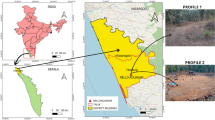Summary
At two dam construction sites in Central America geophysical tests were conducted in a karstic environment in order to evaluate the applicability of indirect methods for detecting cavities, fissures and other anomalous features. Geophysical techniques evaluated were ground probing, radar, acoustic seismic and refraction seismic methods. Based upon the results of geophysical tests and their comparison to known geologic conditions it was concluded that the radar technique showed the greates promise for use as an aid and “guiding-tool” in the execution of the grouting programs of either sites. The content of this paper addresses the rational leading to this conclusion.
Résumé
Pour évaluer les possibilités de détection des cavités, des fissures et autres anomalies dans un environnement karstique par des méthodes indirectes, de essais géophysiques ont été conduits sur deux chantiers de barrage en Amérique Centrale. Les méthodes essayées ont été le radar, la sismique haute fréquence à transmission et la sismique réfraction. La comparaison des résultats de ces essais avec les conditions géologiques effectivement observées a démontré que la technique radar était la plus prometteuse pour être utilisée comme aide et mesure de contrôle dans l'exécution des programmes d'injection des deux sites. Les raisons qui ont mené à cette conclusion sont présentées dans cet article.
Similar content being viewed by others
References
BALLARD R.J., Jr. (1982): Cavity detection. Proc. Intern. Geoscience and remote sensing Symposium, Munich.
BALLARD R.F., Jr. (1983): Electromagnetic techniques applied to cavity detection. Techn. Report GL-83-1, US Army Engineer Waterways Experiment Station, Vicksburg, Mississipi.
FOUNTAIN L.S. and HERZIG F.X. (1980): Earth resistivity and hole-to-hole electromagnetic transmission tests af Medford Cave, Florida. Techn. Report 14-5940, Southwest Research Institute, San Antonio, Texas.
LAINE E.F. (1980): Detection of water-filled and air-filled underground cavities. Report No. UCRL-53127, Lawrence Livermore National Laboratory Livermore, California.
NUREG-CR2062 (1981): Foundation considerations in siting of nuclear facilities in karst terrains and other areas susceptible to ground collapse. US Nuclear Regulatory Commission, Washington DC.
SONEX Ltd (1982): Borehole sonar investigations at Idaho Springs Colorado, and Manatee Springs, Florida. Richland, Washington.
Author information
Authors and Affiliations
Rights and permissions
About this article
Cite this article
Ballard, R.F., Cuenod, Y. & Jenni, J.P. Detection of karst cavities by geophysical methods. Bulletin of the International Association of Engineering Geology 26, 153–157 (1982). https://doi.org/10.1007/BF02594210
Published:
Issue Date:
DOI: https://doi.org/10.1007/BF02594210




